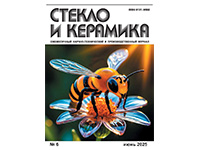Господдержка предприятий-производителей строительных материалов

Dear colleagues!
Viktor Osipov, President of the Association "StekloSouz" of Russia, is a member of the editorial board of the Glass and Ceramics magazine.
We inform you that the 6th issue of the monthly scientific and technical magazine Glass and Ceramics for 2025 has been published.
![]() Contents of the June issue:
Contents of the June issue:
- ELECTRIC POLARIZATION AND MAGNETIC PROPERTIES OF ZINC-TELLURITE GLASSES ACTIVATED BY MAGNETITE AND BARIUM TITANATE NANOPARTICLES
Samples of zinc-tellurite glasses activated by magnetite and barium titanate nanoparticles were synthesized by quenching from the melt. The functional properties of the glasses were experimentally studied using X-ray diffraction, optical and polarization spectroscopy, and SQUID magnetometry. The results of X-ray phase analysis confirm the amorphous structure of the glasses. Based on the optical spectroscopy data, the band gap of the samples was reconstructed. The results of the study of the electric and magnetic field dependences of electric polarization and specific magnetization indicate an evolutionary change in the shape of the electric and magnetic hysteresis loops depending on the composition of the glasses due to the interaction of charged ?-Fe2O3 clusters and barium titanate nanoparticles.
- STATISTICAL ANALYSIS OF THE STRENGTH OF SHEET GLASS UNDER STATIC LOADS
A study of statistical data on the strength of sheet glass was carried out. The article considers the issues of theoretical models of sheet glass strength, parameters affecting its strength, probabilistic nature of sheet glass failure under operating conditions of building glazing, selection of sheet glass strength value distribution, data censoring, determination of probabilistic characteristics of sheet glass strength, including the standard bending strength limit.
- TAKING INTO ACCOUNT REFLECTION FROM THE BACK SURFACE DURING LASER ANNEALING OF OPTICAL GLASS PLATES WITH HIGH REFRACTIVE INDEX VALUES
Within the framework of a quasi-static uncoupled thermoelasticity problem, a criterion for the thermal strength of a freely clamped plate under pulsed laser annealing is obtained taking into account the reflection of laser radiation from the back surface of the plate. The possibility of reducing the maximum tensile stresses in the plate by 15...65% and the energy costs for annealing by 8...30% is shown. It has been established that taking into account the reflection of laser radiation from the back surface of the plate leads to a decrease in the region of variation of the dimensionless parameter ?h (the product of the absorption coefficient and the plate thickness), in which destruction of the plate by thermoelastic stresses during the annealing process is possible.